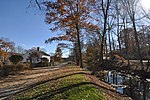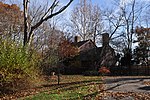Berkeley Mill Village

Berkeley Mill Village is a historic district encompassing the mill village of Berkeley in Cumberland, Rhode Island. The village is roughly bounded by Martin Street and Mendon Road on the north and east, railroad tracks to the west, and St. Joseph Cemetery to the south. The village, including a mill complex and mill employee housing, was built in 1872 by the Lonsdale Company. Most of the residential structures built are two-story brick duplexes, although Mendon Street is lined with a number of fine Queen Anne Victorian houses. A c. 1892 Stick-style church building (now used for non-religious purposes), stands on Mendon Street at the northern end of the district.In 1922, it's textile mills were temporarily shutdown by the New England Textile Strike over an attempted wage cut and hours increase.The district was added to the National Register of Historic Places in 1972.
Excerpt from the Wikipedia article Berkeley Mill Village (License: CC BY-SA 3.0, Authors, Images).Berkeley Mill Village
Mendon Road,
Geographical coordinates (GPS) Address Nearby Places Show on map
Geographical coordinates (GPS)
| Latitude | Longitude |
|---|---|
| N 41.929916 ° | E -71.422702 ° |
Address
Mendon Road 1078
02864
Rhode Island, United States
Open on Google Maps










